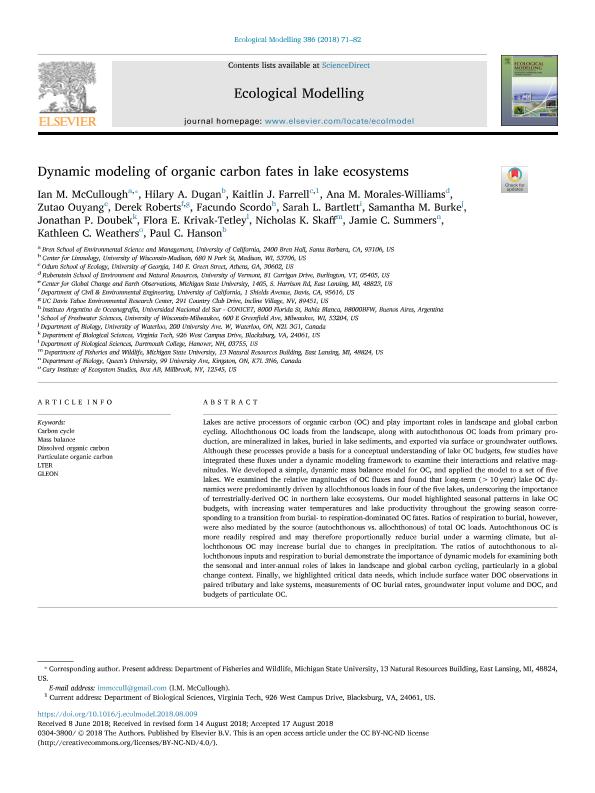Artículo
Dynamic modeling of organic carbon fates in lake ecosystems
McCullough, Ian M.; Dugan, Hilary A.; Farrell, Kaitlin J.; Morales Williams, Ana M.; Ouyang, Zutao; Roberts, Derek; Scordo, Facundo ; Bartlett, Sarah L.; Burke, Samantha M.; Doubek, Jonathan P.; Krivak Tetley, Flora E.; Skaff, Nicholas K.; Summers, Jamie C.; Weathers, Kathleen C.; Hanson, Paul C.
; Bartlett, Sarah L.; Burke, Samantha M.; Doubek, Jonathan P.; Krivak Tetley, Flora E.; Skaff, Nicholas K.; Summers, Jamie C.; Weathers, Kathleen C.; Hanson, Paul C.
 ; Bartlett, Sarah L.; Burke, Samantha M.; Doubek, Jonathan P.; Krivak Tetley, Flora E.; Skaff, Nicholas K.; Summers, Jamie C.; Weathers, Kathleen C.; Hanson, Paul C.
; Bartlett, Sarah L.; Burke, Samantha M.; Doubek, Jonathan P.; Krivak Tetley, Flora E.; Skaff, Nicholas K.; Summers, Jamie C.; Weathers, Kathleen C.; Hanson, Paul C.
Fecha de publicación:
24/10/2018
Editorial:
Elsevier Science
Revista:
Ecological Modelling
ISSN:
0304-3800
Idioma:
Inglés
Tipo de recurso:
Artículo publicado
Clasificación temática:
Resumen
Lakes are active processors of organic carbon (OC) and play important roles in landscape and global carbon cycling. Allochthonous OC loads from the landscape, along with autochthonous OC loads from primary production, are mineralized in lakes, buried in lake sediments, and exported via surface or groundwater outflows. Although these processes provide a basis for a conceptual understanding of lake OC budgets, few studies have integrated these fluxes under a dynamic modeling framework to examine their interactions and relative magnitudes. We developed a simple, dynamic mass balance model for OC, and applied the model to a set of five lakes. We examined the relative magnitudes of OC fluxes and found that long-term (>10 year) lake OC dynamics were predominantly driven by allochthonous loads in four of the five lakes, underscoring the importance of terrestrially-derived OC in northern lake ecosystems. Our model highlighted seasonal patterns in lake OC budgets, with increasing water temperatures and lake productivity throughout the growing season corresponding to a transition from burial- to respiration-dominated OC fates. Ratios of respiration to burial, however, were also mediated by the source (autochthonous vs. allochthonous) of total OC loads. Autochthonous OC is more readily respired and may therefore proportionally reduce burial under a warming climate, but allochthonous OC may increase burial due to changes in precipitation. The ratios of autochthonous to allochthonous inputs and respiration to burial demonstrate the importance of dynamic models for examining both the seasonal and inter-annual roles of lakes in landscape and global carbon cycling, particularly in a global change context. Finally, we highlighted critical data needs, which include surface water DOC observations in paired tributary and lake systems, measurements of OC burial rates, groundwater input volume and DOC, and budgets of particulate OC.
Archivos asociados
Licencia
Identificadores
Colecciones
Articulos(IADO)
Articulos de INST.ARG.DE OCEANOGRAFIA (I)
Articulos de INST.ARG.DE OCEANOGRAFIA (I)
Citación
McCullough, Ian M.; Dugan, Hilary A.; Farrell, Kaitlin J.; Morales Williams, Ana M.; Ouyang, Zutao; et al.; Dynamic modeling of organic carbon fates in lake ecosystems; Elsevier Science; Ecological Modelling; 386; 24-10-2018; 71-82
Compartir
Altmétricas



